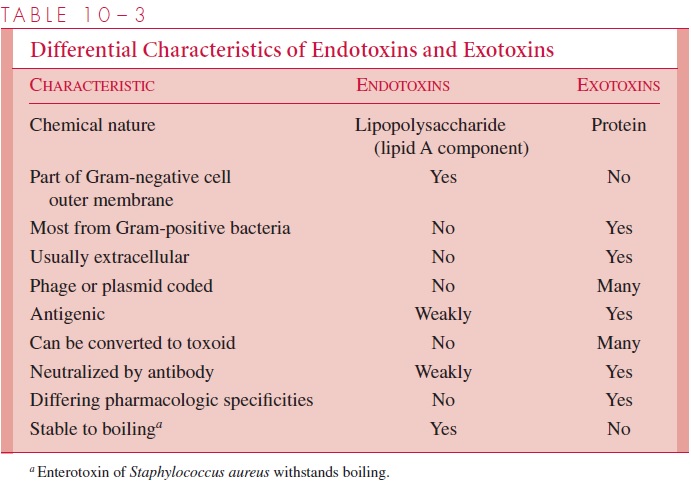Chapter: Medical Microbiology: An Introduction to Infectious Diseases: Host-Parasite Relationships
Endotoxin - Virulence Factors: Toxins
Endotoxin
In many infections caused by Gram-negative organisms, the endotoxin of the outer membrane is a significant component of the disease process. Recall that endotoxin is a lipopolysaccharide and that the lipid portion (lipid A) is the toxic portion. The conserved polysaccharide core and the variable O-polysaccharide side chains of endo-toxin are responsible for the antigenic diversity seen among enteric bacterial species. The major characteristics of endotoxin are contrasted with those of exotoxin in Table 10 – 3. As noted earlier, endotoxin is a major cue to the human innate defense system that bacter-ial multiplication is taking place in the tissues. Endotoxin in nanogram amounts causes fever in humans through release of IL-1 and TNF from macrophages. In larger amounts, whether on intact Gram-negative organisms or cell wall fragments, it produces dramatic physiologic effects associated with inflammation. These include hypotension, lowered polymorphonuclear leukocyte and platelet counts from increased margination of these cells to the walls of the small vessels, hemorrhage, and sometimes disseminated intravas-cular coagulation from activation of clotting factors. Rapid and irreversible shock may follow passage of endotoxin into the bloodstream. This syndrome is seen when materials that have become heavily contaminated are injected intravenously or when a severe local infection leads to massive bacteremia. The role of endotoxin in more chronic disease processes is less clear, but some manifestations of typhoid fever and meningococcal septicemia, for example, are fully compatible with the known effects of endotoxin in humans. It should be noted that endotoxins are considerably less active than many exotoxins, incompletely neutralized by antibody against their carbohydrate component, and stable even to autoclaving.

The latter characteristic is important, because materials for intravenous administration that have become contaminated with Gram-negative organ-isms are not detoxified by sterilization.
Gram-positive bacteria do not contain endotoxin but they release peptidoglycan frag-ments and other cell wall determinants that act to “alarm” the host to the presence of bac-teria in the tissues. The same cytokines are released and the same physiologic cascade is seen.
Related Topics